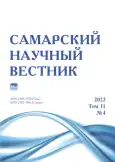Fungi of the Russulaceae family in the conditions of natural monuments of the Penza region and the influence of environmental factors on their distribution
- Authors: Ivanov A.I.1, Mironova A.A.2, Novikova L.A.2, Ermolaeva A.A.1
-
Affiliations:
- Penza State Agrarian University
- Penza State University
- Issue: Vol 11, No 4 (2022)
- Pages: 39-46
- Section: Biological Sciences
- URL: https://journals.rcsi.science/2309-4370/article/view/133215
- DOI: https://doi.org/10.55355/snv2022114105
- ID: 133215
Cite item
Full Text
Abstract
The relevance of the study of fungi of the Russulaceae family is determined by the fact that they play an important role in the life of temperate forest ecosystems as mycorrhizal symbionts of the main forest-forming tree species. In addition, this group of fungi is of great practical importance, as they are edible fungi. Despite this, they are one of the little studied groups of Agaricomycetes. The information about the fungi of the studied family in the conditions of the Russian Federation is limited, and therefore the data on their ecology are contained mainly in foreign literature. The purpose of this work is to study the species composition of fungi of the Russulaceae family and to establish the influence of the main environmental factors on the distribution of this group of fungi on the territory of some forest natural monuments of regional significance («Burchikhinsky slopes», «Zasursky blueberry forest», «Kichkleysky pine forest with oak», «Nikonovsky forest» and «Floodplain oak forest») in the conditions of the Penza region. The studies were carried out in 2016–2022 by methods of route and stationary studies. When determining fungi, the method of light microscopy was used. As a result, the species composition of fungi of the Russulaceae family of the studied natural monuments located in the Penza region was studied. Within the studied protected areas, 78 species of fungi of the Russulaceae family were identified. As a result of the taxonomic analysis of mycobiota, it was found that it included 24 species from the genus Lactarius, 3 from the genus Lactifluus, and 51 from the genus Russula. All of them belong to the ecological-trophic group of symbiotrophs. 19 species form mycorrhiza with various tree species, and 59 species have a narrow specialization in relation to partners in symbiosis (29 species are associated with Quercus robur, 15 with Betula pendula, 10 with Pinus sylvestris, 2 with Populus tremula, 1 with Tilia cordata, 1 with Alnus glutinosa and 1 with Corylus avellana). It has been established that the leading factors determining spatial distribution and productivity of fruiting bodies of fungi of the studied family are soil fertility and moisture. In megatrophic habitat conditions, acidity also has a significant effect on the distribution of fungi of the family under consideration. The species composition of fungi of the Russulaceae family for habitat types was determined in accordance with the edaphic grid. For different ecotopes, the composition of indicator species was revealed. An estimate of the yield of fruiting bodies of fungi of the Russulaceae family in various types of forests, depending on fertility and soil moisture, is given.
Full Text
##article.viewOnOriginalSite##About the authors
Alexander Ivanovich Ivanov
Penza State Agrarian University
Email: rcgekim@mail.ru
doctor of biological sciences, professor of Breeding, Seed Production and Biology of Plants Department
Russian Federation, PenzaAnna Andreevna Mironova
Penza State University
Email: mironovaanna20@gmail.com
head of I.I. Sprygin Herbarium
Russian Federation, PenzaLyubov Aleksandrovna Novikova
Penza State University
Author for correspondence.
Email: la_novikova@mail.ru
doctor of biological sciences, professor of General Biology and Biochemistry Department
Russian Federation, PenzaAnastasia Aleksandrovna Ermolaeva
Penza State Agrarian University
Email: ermolaeva7733@yandex.ru
lecturer of secondary vocational education of Physical Education Department
Russian Federation, PenzaReferences
- Шапорова Я.А. Руссуляльные грибы Беларуси: Lactarius и Russula (млечники и сыроежки). Минск: Белорусская наука, 2007. 275 с.
- Шубин В.И. Микотрофность древесных пород, ее значение при разведении леса в таежной зоне. Л.: Наука. Ленингр. отд-ние, 1973. 263 с.
- Smith S.E., Read D.J. Mycorrhizal symbiosis. London: Academic Press, 1997. 605 p.
- Bolshakov S., Kalinina L., Palomozhnykh E., Potapov K., Ageyev D., Arslanov S., Filippova N., Palamarchuk M., Tomchin D., Voronina E. Agaricoid and boletoid fungi of Russia: the modern country-scale checklist of scientific names based on literature data // Biological Communications. 2021. Vol. 66, № 4. P. 316–325. doi: 10.21638/spbu03.2021.404.
- Булах Е.М. Сем. Russulaceae – Сыроежковые // Низшие растения, грибы и мохообразные советского Дальнего Востока. Грибы. Т. 1. Базидиомицеты / отв. ред. С.П. Вассер. Л.: Наука, 1990. С. 13–117.
- Калинина Л.Б. Агарикоидные грибы широколиственных лесов северо-запада европейской части России (Ленинградская, Новгородская и Псковская области): автореф. дис. … канд. биол. наук: 03.02.12. СПб., 2021. 26 с.
- Funga Nordica. Agaricoid, Boletoid, Cypheloid and Gasteroid genera / eds. H. Knudsen, J. Vesterholt. Copenhagen: Nordsvamp, 2012. P. 597–606.
- Kalamees K. Riisikad. The genus Lactarius in Estonia. Tartu: TU Kirjastus, 2011. 187 p.
- Иванов А.И. К флоре агариковых грибов Пензенской области // Новости систематики низших растений. 1981. Т. 18. С. 86–93.
- Иванов А.И. К флоре агариковых грибов Пензенской области. IV // Новости систематики низших растений. 1985. Т. 22. С. 117–119.
- Иванов А.И., Чернышов Н.В., Кузин Е.Н. Природные условия Пензенской области: современное состояние. Т. 1. Геологическая среда, рельеф, климат, поверхностные воды, почвы, растительный покров: монография. Пенза: РИО ПГАУ, 2017. 236 с.
- Бондарцев А.С., Зингер Р.А. Руководство по сбору высших базидиальных грибов для научного их изучения. М.–Л.: Изд-во АН СССР, 1950. 73 с.
- Ивойлов А.В., Большаков С.Ю., Силаева Т.Б. Изучение видового разнообразия макромицетов: учеб. пособие / под общ. ред. А.Е. Коваленко, О.В. Морозовой. Саранск: Изд-во Мордов. ун-та, 2017. 160 с.
- Bon M. Clé monographique des Russules d’Europe // Documents mycologiques. 1988. Vol. 18. P. 1–120.
- Index Fungorum [Internet] // http://indexfungorum.org.
- Погребняк П.С. Основы лесной типологии. 2-е изд., доп. и испр. Киев: АН УССР, 1955. 452 с.
- Шмидт В.М. Статистические методы в сравнительной флористике. Л.: Изд-во ЛГУ, 1980. 176 с.








